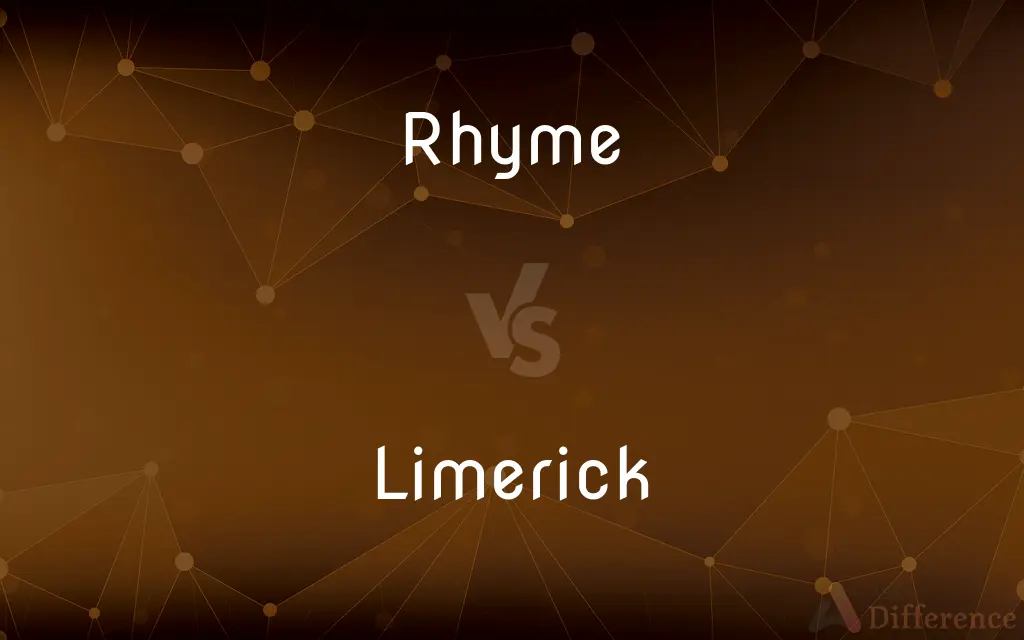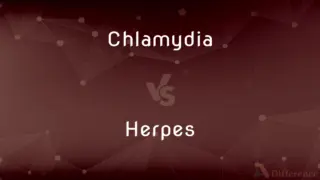Rhyme vs. Limerick — What's the Difference?
By Tayyaba Rehman & Maham Liaqat — Updated on April 2, 2024
Rhyme is the repetition of similar sounds in the final stressed syllables of two or more words, often used in poetry. Limericks are humorous five-line poems with a distinct rhythm and rhyme scheme (AABBA).

Difference Between Rhyme and Limerick
Table of Contents
ADVERTISEMENT
Key Differences
Rhyme is a literary device involving the repetition of similar sounding words, typically at the end of lines in poems or songs, creating a melodious effect. Limericks, on the other hand, are a type of poetry with a specific structure: they consist of five lines, where the first, second, and fifth lines rhyme with each other, and the third and fourth lines form a rhymed pair.
While rhymes are primarily about the echoing of sounds and can be found in various types of poetry and songs, limericks are known for their specific format and often humorous content. The rhythm in limericks is distinctive, with a particular meter that lends itself to comedic timing.
Rhymes enhance the musicality and aesthetic appeal of verses, and can be employed in different patterns such as couplets, alternating rhymes, or slant rhymes. Limericks, however, follow a strict AABBA rhyme scheme and usually have a bouncy rhythm, making them easily recognizable and enjoyable.
In the context of literature and poetry, rhymes play a crucial role in adding harmony and aiding memory, serving as a versatile tool for poets. Limericks distinguish themselves by not only utilizing rhyme but also by incorporating a specific meter, the anapestic trimeter for the longer lines and anapestic dimeter for the shorter, which adds a playful cadence.
The use of rhyme can vary widely, from subtle internal rhymes within lines to end rhymes that punctuate the poem's rhythm. Limericks, due to their structure, often contain puns, wordplay, or twists in the final line, highlighting the punchline of the joke or story being told.
ADVERTISEMENT
Comparison Chart
Definition
Repetition of similar sounds in two or more words, often at the end of lines.
A humorous five-line poem with a specific rhythm and rhyme scheme (AABBA).
Purpose
Enhances musicality, aesthetic appeal, and aids memory in poetry.
Designed to amuse, with a specific structure and playful rhythm.
Structure
Can be flexible, varying across different patterns and types of poetry.
Strict, with a set meter (anapestic) and rhyme scheme (AABBA).
Use in Poetry
Widespread across various forms and styles.
Confined to a specific five-line humorous form.
Effect
Adds harmony and rhythm, making verses more memorable.
Creates a comedic effect through a distinctive beat and clever wordplay.
Compare with Definitions
Rhyme
The repetition of similar sounds in the final stressed syllables of two or more words, often at the end of lines in poetry.
The cat sat on the mat, showcasing simple rhyme.
Limerick
A humorous five-line poem with a specific meter (anapestic) and a rhyme scheme of AABBA.
There once was a man from Peru, a classic start to a limerick.
Rhyme
Rhymes can vary in pattern and placement, including internal and slant rhymes.
She sings with a ring, demonstrating internal rhyme.
Limerick
Comprised of five lines with a strict rhyme scheme and rhythm.
The first, second, and fifth lines have eight to nine syllables, while the third and fourth lines have five to six.
Rhyme
Enhances the musical quality of poetry and songs.
The rhyming lines flowed like a gentle river, creating harmony.
Limerick
Primarily used for comedic and often nonsensical verses.
Limericks often tell a short, amusing tale or joke.
Rhyme
Makes lyrics and poetry easier to remember.
Nursery rhymes use simple rhymes, aiding in memorization.
Limerick
The anapestic meter gives limericks a distinctive bouncy rhythm.
The cadence of a limerick is unmistakable and adds to its humor.
Rhyme
Utilized in numerous forms of poetry, from sonnets to free verse.
In sonnets, the final couplet rhymes, adding a concluding thought.
Limerick
Often contains puns, wordplay, or a twist in the final line.
The surprise ending often brings a laugh or a groan.
Rhyme
A rhyme is a repetition of similar sounds (usually, exactly the same sound) in the final stressed syllables and any following syllables of two or more words. Most often, this kind of perfect rhyming is consciously used for artistic effect in the final position of lines within poems or songs.
Limerick
Limerick ( LIM-ər-ik; Irish: Luimneach [ˈl̪ˠɪmʲ(ə)nʲəx]) is a western city in Ireland situated within County Limerick. It is in the province of Munster and is located in the Mid-West which comprises part of the Southern Region.
Rhyme
Correspondence of sound between words or the endings of words, especially when these are used at the ends of lines of poetry
Poetic features such as rhythm, rhyme, and alliteration
Limerick
A light humorous, nonsensical, or bawdy verse of five usually anapestic lines with the rhyme scheme aabba, in which the first, second, and fifth lines are in trimeter, and the third and fourth lines are in dimeter.
Rhyme
(of a word, syllable, or line) have or end with a sound that corresponds to another
Balloon rhymes with moon
Limerick
A humorous, often bawdy verse of five anapaestic lines, with the rhyme scheme aabba, and typically having an 8–8–5–5–8 cadence.
Rhyme
Correspondence of sounds at the ends of words or phrases, especially when involving the last stressed vowel and all succeeding sounds in each of two or more such words or phrases.
Limerick
A humorous, often nonsensical, and sometimes risqé poem of five anapestic lines, of which lines 1, 2, and 5 are of three feet, and rhyme, and lines 3 and 4 are of two feet, and rhyme.
There was a young lady, Amanda,Whose Ballades Lyriques were quite fin deSiècle, I deemBut her Journal IntimeWas what sent her papa to Uganda.
Rhyme
A word that exhibits such correspondence with another, as behold and cold.
Limerick
Port city in southwestern Ireland
Rhyme
A poem or verse employing such correspondence as a formal feature, especially at the ends of lines.
Limerick
A humorous verse form of 5 anapestic lines with a rhyme scheme aabba
Rhyme
Poetry or verse of this kind.
Rhyme
To form a rhyme.
Rhyme
To compose rhymes or verse.
Rhyme
To make use of rhymes in composing verse.
Rhyme
To put into rhyme or compose with rhymes.
Rhyme
To use (a word or words) as a rhyme.
Rhyme
Rhyming verse (poetic form)
Rhyme
A thought expressed in verse; a verse; a poem; a tale told in verse.
Rhyme
(countable) A word that rhymes with another.
Rhyme
A word that rhymes with another, in that it is pronounced identically with the other word from the vowel in its stressed syllable to the end.
Rhyme
(uncountable) Rhyming: sameness of sound of part of some words.
Rhyme
(linguistics) rime
Rhyme
(obsolete) Number.
Rhyme
(ambitransitive) To compose or treat in verse; versify.
Rhyme
Of a word, to be pronounced identically with another from the vowel in its stressed syllable to the end.
Rhyme
(reciprocal) Of two or more words, to be pronounced identically from the vowel in the stressed syllable of each to the end of each.
Rhyme
To somewhat resemble or correspond with.
Rhyme
To number; count; reckon.
Rhyme
An expression of thought in numbers, measure, or verse; a composition in verse; a rhymed tale; poetry; harmony of language.
A ryme I learned long ago.
He knewHimself to sing, and build the lofty rime.
Rhyme
Correspondence of sound in the terminating words or syllables of two or more verses, one succeeding another immediately or at no great distance. The words or syllables so used must not begin with the same consonant, or if one begins with a vowel the other must begin with a consonant. The vowel sounds and accents must be the same, as also the sounds of the final consonants if there be any.
For rhyme with reason may dispense,And sound has right to govern sense.
Rhyme
Verses, usually two, having this correspondence with each other; a couplet; a poem containing rhymes.
Rhyme
A word answering in sound to another word.
Rhyme
To make rhymes, or verses.
There marched the bard and blockhead, side by side,Who rhymed for hire, and patronized for pride.
Rhyme
To accord in rhyme or sound.
And, if they rhymed and rattled, all was well.
Rhyme
To put into rhyme.
Rhyme
To influence by rhyme.
Hearken to a verser, who may chanceRhyme thee to good.
Rhyme
Correspondence in the sounds of two or more lines (especially final sounds)
Rhyme
A piece of poetry
Rhyme
Compose rhymes
Rhyme
Be similar in sound, especially with respect to the last syllable;
Hat and cat rhyme
Common Curiosities
Can a limerick be serious in tone?
While traditionally humorous, limericks can be written with a serious tone, though this is less common.
How do rhymes contribute to the musicality of a poem?
Rhymes add a sense of harmony and rhythm, making the poem more pleasing to the ear and memorable.
Can rhymes appear in the middle of lines?
Yes, this is known as internal rhyme and is another way poets use rhymes beyond the end of lines.
Can rhymes be used in prose?
Yes, rhymes can be used in prose, often for artistic effect or to highlight particular segments of text.
Why are limericks often humorous?
The structure and rhythm of limericks lend themselves to playful storytelling and punchlines, making humor a key element.
Is it easier to write a rhyme or a limerick?
Writing a simple rhyme might be easier due to its flexibility, whereas limericks require adherence to a specific structure and rhythm.
Are all poems with rhymes considered limericks?
No, only poems that follow the specific five-line structure and AABBA rhyme scheme of limericks are considered as such.
What is the main difference between a rhyme and a limerick?
A rhyme is the repetition of sounds in words, while a limerick is a structured, humorous five-line poem with a specific rhyme scheme.
Can a limerick contain rhymes that are not part of the AABBA scheme?
By definition, limericks strictly adhere to the AABBA rhyme scheme, so additional rhymes would alter its traditional structure.
Do all cultures use rhymes in poetry?
While the use of rhyme is widespread, its prevalence and forms can vary significantly across different cultures and literary traditions.
What makes a limerick unique compared to other poetic forms?
Its fixed structure, distinctive rhythm, and humorous content set limericks apart from other poetry forms.
Are limericks considered a form of high art?
While limericks are often viewed as light entertainment, their creativity and linguistic playfulness have earned them recognition in the literary world.
Share Your Discovery

Previous Comparison
Chlamydia vs. Herpes
Next Comparison
Pheochromocytoma vs. NeuroblastomaAuthor Spotlight
Written by
Tayyaba RehmanTayyaba Rehman is a distinguished writer, currently serving as a primary contributor to askdifference.com. As a researcher in semantics and etymology, Tayyaba's passion for the complexity of languages and their distinctions has found a perfect home on the platform. Tayyaba delves into the intricacies of language, distinguishing between commonly confused words and phrases, thereby providing clarity for readers worldwide.
Co-written by
Maham Liaqat















































